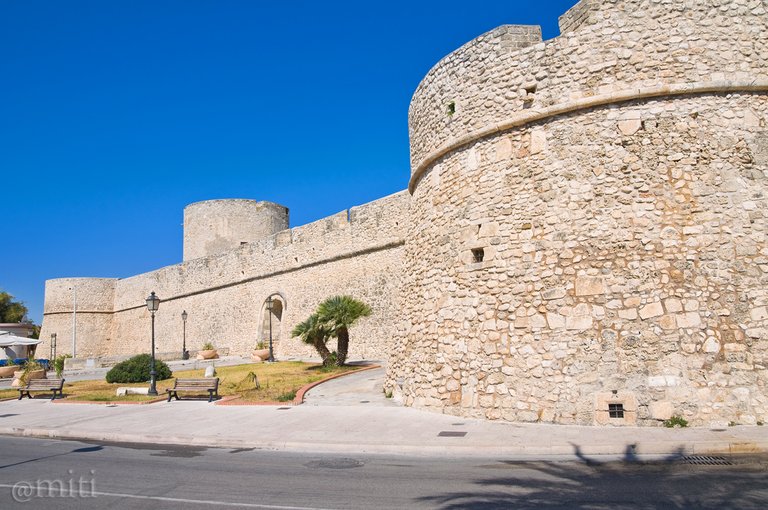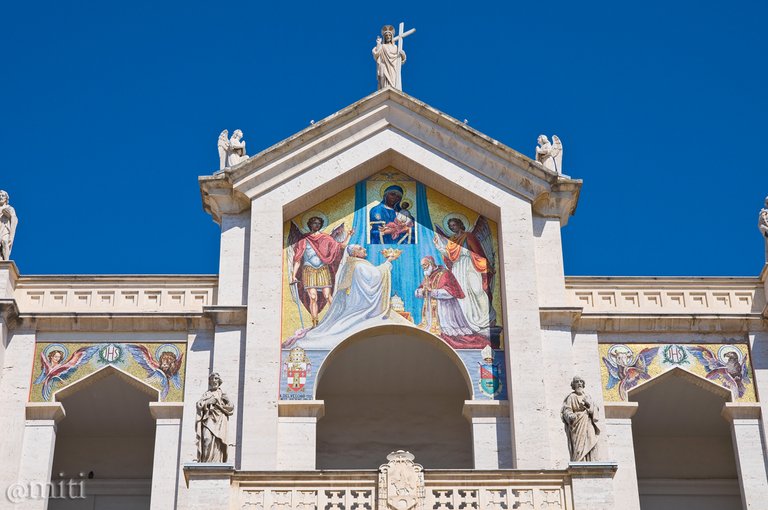
The Swabian- Angevine Castle (Author's photo - All rights reserved)
Il Castello Svevo-Angioino (Immagine dell'autore - tutti i diritti sono riservati)



Ciao a tutti,
questo è un viaggio attraverso l'Italia. Posterò una foto al giorno con una brevissima descrizione. Spero vi piaccia!

Manfredonia è una città nella provincia di Foggia, nella regione italiana meridionale della Puglia. Si trova sulle pendici del Gargano, sulla riva del golfo. Manfredi, re di Sicilia, abbandonò il porto del vecchio Siponto per fondare questa città.
Nell'antichità Siponto era un importante centro per la gente della cosiddetta "Dáunia" (il popolo dei "Dauni", di origine illirica). Siponto fu poi conquistata da Pirro nel 330 aC, e soggiogata dai Romani, che qui fondarono una colonia nel 194 aC.
La città fu contesa a lungo tra Bizantini e Longobardi, poi occupata dai Normanni nel 1039.
Nel tardo Medioevo perse importanza a causa del porto che fu invaso dalle paludi.
Una combinazione di pirati e terremoti del 1223 e del 1255 rovinò il "vecchio Siponto". Gli abitanti furono quindi raccolti da Manfredi, figlio di Federico II di Svevia (1194-1250), in una nuova città a breve distanza a nord-ovest.
Si chiamava Mandredonia, in onore di Manfredi, che, come suo padre, aveva ambizioni importanti per Manfredonia, che voleva diventasse la capitale amministrativa della Puglia.
La bellissima cattedrale e la fortezza svevo-angioina, a picco sul mare, sede del Museo Archeologico Nazionale, furono anch'esse progettate da Manfredi. Qui si possono ammirare i resti della vecchia Sipontum, insieme ai reperti archeologici di Coppa Nevigata e del Monte Saraceno, e all’affascinante Basilica di Santa Maria di Siponto.
Poco distante, sorge l’Abbazia di San Leonardo, costruita dai Templari e tappa importante della via Francigena del Sud.
La cattedrale originale fu distrutta dai Turchi nel 1620, dopo di che la ricostruzione fu lenta. Le difficoltà nella città in quel momento spiegano perché la nuova versione è di dimensioni più modeste rispetto all'antica cattedrale.
Il centro storico è caratterizzato da palazzi nobiliari e piccole case in pietra o tufo. In piazza del Popolo spiccano il Palazzo Comunale e la Chiesa di San Domenico, mentre la Chiesa di San Francesco è un piccolo gioiello gotico.
Un'altra chiesa interessante è la Chiesa di San Benedetto che consiste in una grande navata unica, con pareti laterali adornate da coppie di pilastri decorati con stucchi. La chiesa di Santa Chiara fu consacrata nel 1680 dal cardinale Orsini.
Il castello di Manfredonia fu iniziato da re Manfredi tra il 1256 e il 1259 e fu terminato sotto Carlo d'Angiò. Ha una torre quadrilatera e quattro torri angolari (tre cilindriche e una quadrilatera), queste ultime sono state aggiunte nel XVI secolo.
La quarta torre, rivolta verso la città, fu sostituita da un bastione pentagonale dopo l'assedio del 1528 ed è stata progettata per sostenere colpi di artiglieria.
Cosa vedere: il centro storico, il Castello svevo-angioino, la Cattedrale, la chiesa di San Domenico, la chiesa di San Francesco, la chiesa di San Benedetto, la chiesa di Santa Chiara, l'abbazia di San Leonardo, il Museo Archeologico Nazionale, la Basilica di Santa Maria di Siponto, il Palazzo Comunale.

Hello everyone,
I began a Photo Journey through Italy. I will post one photo every day with a little note of explanation. I hope you like it!

Manfredonia is a town in the province of Foggia, in the Southern Italian region of Puglia. It is located on Gargano slopes, on the shore of the gulf. Manfred, king of Sicily, abandoned the port of the old Siponto to found this town.
In ancient times Siponto was an important centre for the so-called “Dáunia” people (the people of the “Dauni”, of Illyrian origin). Siponto was then conquered by Pyrrhus in 330 BC, and subjugated by the Romans, who founded a colony here in 194 BC.
The city was long contended between the Byzantines and the Lombards, then later occupied by the Normans in 1039. In the late Middle Ages it lost importance due to the port becoming overrun by the marshes.
A combination of pirates and the earthquakes of 1223 and 1255 ruined 'old Siponto'. The inhabitants was therefore collected by Manfredi, son of Frederick II of Swabia (1194-1250), in a new city a short distance to the northwest. This was called Mandredonia, in honour of Manfredi, who, like his father, had an important strategy for Manfredonia, that he wanted to become the administrative capital of Apulia.
The beautiful Cathedral and the Swabian- Angevine fortress, dropping sheer into the sea, the seat of the National Archaeological Museum, were also designed by Manfred. Here it is possible to admire the ruins of the ancient Sipontum, together with the archaeological finds of Coppa Nevigata and Saraceno Mountain, and the fascinating Basilica of Santa Maria di Siponto. Not far away from here, there is the Abbey of San Leonardo, built by Knights Templar and an important stop-off along the pilgrims’ route Via Francigena of the South.
The original cathedral was destroyed by the Turks in 1620, after which reconstruction was slow. Hardship in the town at that time explains why the new version is more modest in size than the ancient Cathedral.
The historic centre is characterised by noble palaces and small houses made of stone or tufa. In piazza del Popolo stand out the Palazzo Comunale (Town Hall) and the Church of San Domenico, while the Church of San Francesco is a small gothic gem.
Another church of interest is the Church of San Benedetto which consists of a large single nave, with side walls adorned by pairs of pilasters decorated with stucco. The Church of Santa Chiara was consecrated in 1680 by Cardinal Orsini.
Manfredonia Castle was started by King Manfred between 1256 and 1259 and was finished under Charles of Anjou. It has a quadrilateral tower and four angular towers (three cylindrical and one quadrilateral), the latter towers being added in the 16th century.
The fourth tower, facing towards the city, was replaced by a pentagonal bastion after the siege of 1528 and is designed to support artillery shots.
Thing to see: the Historical center, the Swabian- Angevine Castle, the Cathedral, the Church of San Domenico, the Church of San Francesco, the Church of San Benedetto, the Church of Santa Chiara, the Abbey of San Leonardo, the National Archaeological Museum, the Basilica of Santa Maria di Siponto, the Palazzo Comunale.

| Tipo di foto / Category | Paesaggio / Landscape view |
| Esposizione / Settings | 1/320 sec, ISO 200, f/10 |
| Camera | Nikon D5000 |
| Lente / Lens | Tamron SP 17-50mm f/2.8 XR Di II LD |
| Filtro / Filter | Polarizzatore Hoya / Hoya Polarizing filter |
| Cavalletto / Tripod | Manfrotto MKC3-P01 |
| Località / Location | Manfredonia (Foggia), Italia |
| Software | Photoshop |


The Cathedral of Manfredonia (Author's photo - All rights reserved)
La Cattedrale di Manfredonia (Immagine dell'autore - tutti i diritti sono riservati)
lovely sunshine
By now I have seen a few posts from you that are based on Puglia region in Italy. I am assuming that this region must be very rich in cultural and archeological history of Italy.
It is a blessing to be able to have such a rich history spread throughout the land, which allows one to know more about their ancestors
Yes, Puglia is a region with a deep history and rich culture. But the whole italy is, actually.
Congratulations, Your Post Has Been Added To The Steemit Worldmap!
Author link: http://steemitworldmap.com?author=miti
Post link: http://steemitworldmap.com?post=a-journey-through-italy-one-photo-every-day-88---manfredonia-engita
Want to have your post on the map too?
Alcuni anni fa i miei familiari sono andati a Manfredonia, ma io sono rimasto a casa causa malanno stagionale. Mi avevano raccontato che fosse una bella città, ma grazie alle tue foto e il testo del tuo post, stasera quando glielo farò vedere, potranno rivivere quella vacanza.
Bravo!
Grazie.. avranno sicuramente un bel ricordo.
Friend miti, how beautiful is the cathedral, it looks very modern. And the castle looks very broad and strong. Excellent photographs
Thank you ;-)
A pleasant place it will be. Would love to be there with my significant other @loso. It is a gift to have the capacity to have such a rich history spread all through the land, which enables one to find out about their progenitors
Yes, it's a lovely thought.
Hi, @miti I would like to read your upcoming post, I have already followed and upvoted you, thank you for sharing this type of Post.
You're welcome.
@miti amazing hd picture and castle walls looks very strong and.miti bro my typing mistake in your last post i type italy a city i know bro italy is a beautifull country
No problem ;-)
very nice......
Excellent article. I really liked it. Good luck to you and Love.
Your comment is considered SPAM... Take a look in this guide:
https://steemit.com/steemit/@miti/a-complete-guide-for-newcomers-and-minnows-to-avoid-a-possible-spam-and-to-write-good-comments
It will help you.
Nice